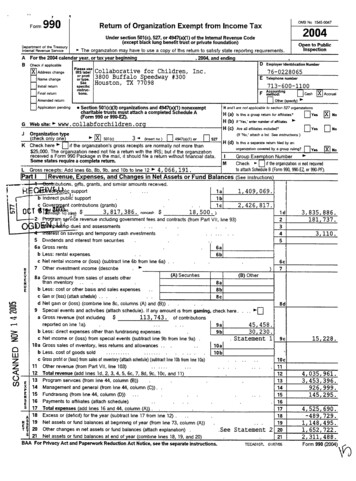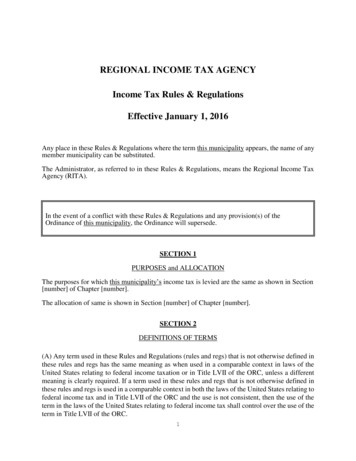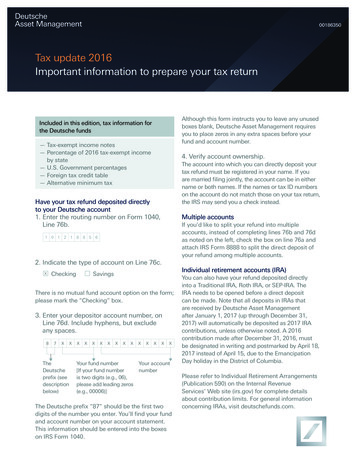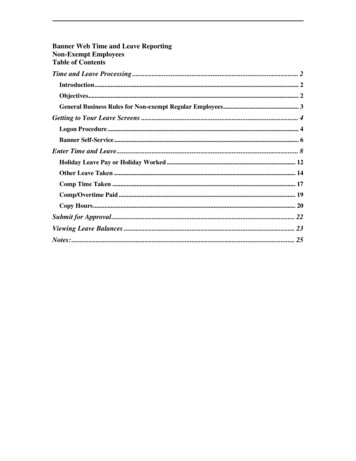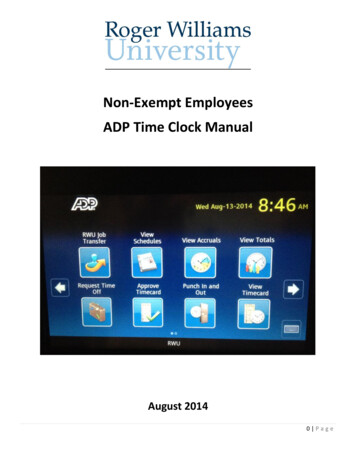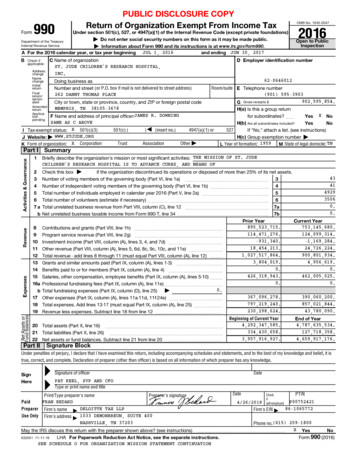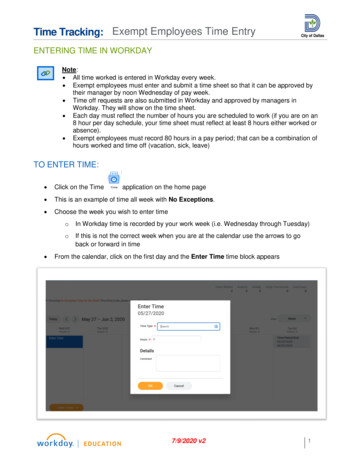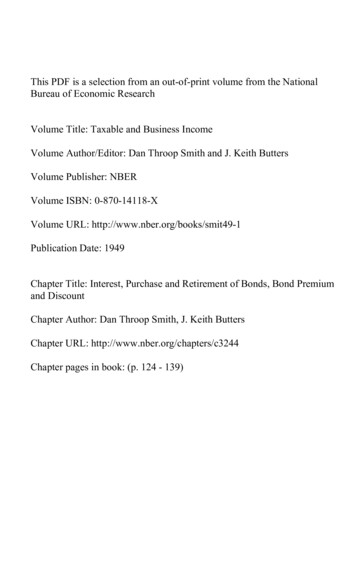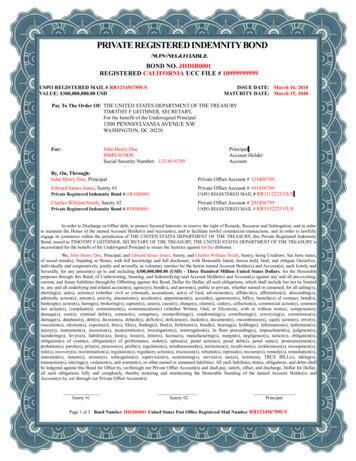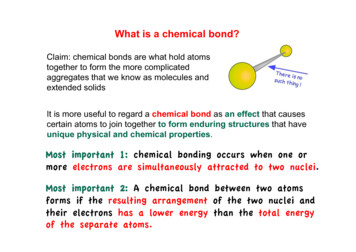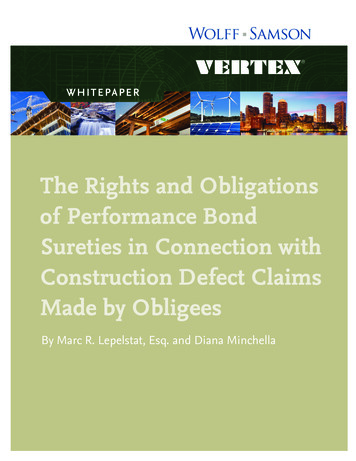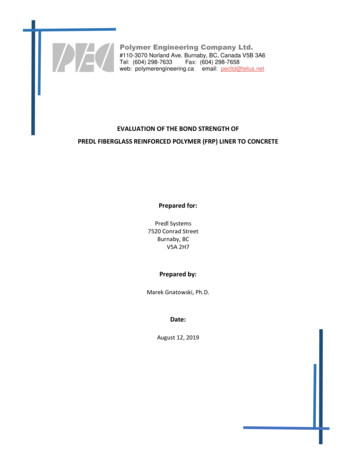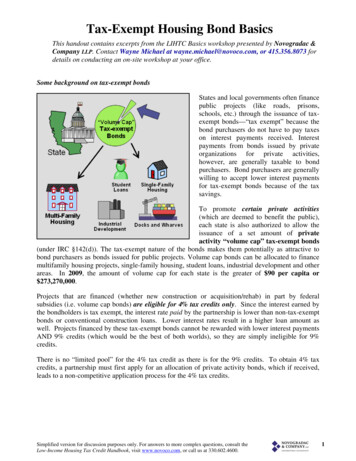
Transcription
Tax-Exempt Housing Bond BasicsThis handout contains excerpts from the LIHTC Basics workshop presented by Novogradac &Company LLP. Contact Wayne Michael at wayne.michael@novoco.com, or 415.356.8073 fordetails on conducting an on-site workshop at your office.Some background on tax-exempt bondsStates and local governments often financepublic projects (like roads, prisons,schools, etc.) through the issuance of taxexempt bonds—“tax exempt” because thebond purchasers do not have to pay taxeson interest payments received. Interestpayments from bonds issued by privateorganizations for private activities,however, are generally taxable to bondpurchasers. Bond purchasers are generallywilling to accept lower interest paymentsfor tax-exempt bonds because of the taxsavings.To promote certain private activities(which are deemed to benefit the public),each state is also authorized to allow theissuance of a set amount of privateactivity “volume cap” tax-exempt bonds(under IRC §142(d)). The tax-exempt nature of the bonds makes them potentially as attractive tobond purchasers as bonds issued for public projects. Volume cap bonds can be allocated to financemultifamily housing projects, single-family housing, student loans, industrial development and otherareas. In 2009, the amount of volume cap for each state is the greater of 90 per capita or 273,270,000.Projects that are financed (whether new construction or acquisition/rehab) in part by federalsubsidies (i.e. volume cap bonds) are eligible for 4% tax credits only. Since the interest earned bythe bondholders is tax exempt, the interest rate paid by the partnership is lower than non-tax-exemptbonds or conventional construction loans. Lower interest rates result in a higher loan amount aswell. Projects financed by these tax-exempt bonds cannot be rewarded with lower interest paymentsAND 9% credits (which would be the best of both worlds), so they are simply ineligible for 9%credits.There is no “limited pool” for the 4% tax credit as there is for the 9% credits. To obtain 4% taxcredits, a partnership must first apply for an allocation of private activity bonds, which if received,leads to a non-competitive application process for the 4% tax credits.Simplified version for discussion purposes only. For answers to more complex questions, consult theLow-Income Housing Tax Credit Handbook, visit www.novoco.com, or call us at 330.602.4600.1
Bonds: The big pictureWhen an operating partnership (the Borrower) needs to finance a LIHTC project using volume captax-exempt bonds, the partnership needs another entity to issue the bonds on its behalf. So, thepartnership approaches a potential Issuer (typically a city, or a county, or a housing authority) topetition the state authority to issue a portion of the state’s volume cap of Private Activity Bonds. ARegulatory Agreement between the Borrower and the Issuer establishes the Borrower’sresponsibilities regarding the rent and income restrictions and other aspects of leasing theapartment units.The Purchasers of the bonds are typically individuals or entities who simply want to make a goodreturn on their investment. They know nothing about the financial stability of the Borrower (or evenwho the Borrower is, for that matter).Executing a bond purchase agreement with the Issuer, the Underwriter markets the bonds topotential Purchasers and acts as a “middleman” between Purchasers and the other parties. TheUnderwriter will typically even advise the Borrower on selecting the appropriate Issuer and on theprocess for obtaining the volume cap bonds in the first place.Since no one is going to purchase the bonds based on the financial security of the Borrower, afinancial institution with a superior credit rating (“AAA” or “Aaa”) steps in as a Credit Enhancer toguarantee that the Purchasers will receive a return of their capital as well as timely interestpayments.Simplified version for discussion purposes only. For answers to more complex questions, consult theLow-Income Housing Tax Credit Handbook, visit www.novoco.com, or call us at 330.602.4600.2
Confident in the AAA or Aaa rating attached to the bonds, the Purchasers buy the bonds through theUnderwriter. The bond proceeds do NOT go directly to the Borrower, Issuer, or Underwriter butinstead to a Trustee, where they are “held in trust” according to the provisions of a trust indenture,an agreement between the Trustee and the Issuer which outlines the terms for repayment ofproceeds.The Borrower enters into a mortgage note with a lender affiliated with the Credit Enhancer. If theBorrower defaults on the loan, the Credit Enhancer has claim to the project since the CreditEnhancer is still obligated to pay the Purchasers.Contractors and other service providers periodically submit invoices to the Borrower. Typicallymonthly, the Borrower aggregates the invoices, attaching them to a draw requisition for funds to bereleased to the service providers. As months pass, the proceeds are slowly depleted and eventuallythe Project is completed. During this time, the Borrower continues to pay interest on the full valueof the loan and will, at some point, be required to pay back the principal.The Underwriter, Credit Enhancer, and Trustee—and each entity’s respective legal counsel—allwork for a fee. The participation of so many fee-earning parties makes financing costs of taxexempt bond deals incredibly high.The 2008 Housing and Economic Recovery Act (the “2008 Housing Act”) contains a provisionthat should help stretch the bond cap: recycling previously issued bonds. Before the 2008 HousingAct, if volume cap bonds were paid off quickly and subsequently reissued, the reissuing of the bonds“counted” as new bonds against the state’s bond cap. Under the new law, however, a reissued bondwill NOT count against the state’s volume cap as long as 1) it is reissued within six months after theoriginal bond was refunded, 2) the reissuance is within four years of the original issuance, and 3) thereissued bond matures within 34 years of the original issuance.Bond interest and AMTAlthough the interest on volume cap bonds is tax-exempt to the bond purchasers receiving thoseinterest payments, up until July 30, 2008, that interest was still subject to the Alternative MinimumTax (AMT). For any taxpayer subject to AMT, volume cap bonds would have been less attractivethan other income sources not subject to AMT. As part of the 2008 Housing Act, tax-exempthousing bond interest income received from tax-exempt bonds issued after July 30, 2008 is nolonger subject to AMT.Simplified version for discussion purposes only. For answers to more complex questions, consult theLow-Income Housing Tax Credit Handbook, visit www.novoco.com, or call us at 330.602.4600.3
How 4% credits differ from 9% creditsEach LIHTC project will fall into either the 9% category or the 4% category depending upon howthe project is financed (9% conventional construction loan, which converts to a permanent loanafter construction is finalized; 4% tax-exempt bonds).The 9% and 4% categories are further divided by the construction method of the project—constructing the project from the ground up OR acquiring an existing project and rehabilitating it(rehabilitation must be completed within 24 months to be eligible for tax credits).NOTE: The IRS treats the acquisition costs and rehabilitation costs as separate “buildings” for taxcredit purposes. Details of this treatment will be explained for fully in the LIHTC Calculationportion of this handout.Projects financed with a conventional construction loan (normal interest rate; from a conventionallender; not “federally subsidized”) are eligible for 9% credits. However, acquisition costs of anexisting project are eligible only for 4% credits. The higher credit percentage for rehabilitating theproject rewards the partnership for improving a project and not merely acquiring it.There are a limited amount of 9% tax credits made available to the state housing agencies each yearas defined in the Internal Revenue Code. Since the total annual 9% credits are limited, they arecalled “competitive” credits. Each partnership wanting an allocation of 9% credits submits anapplication to the state housing agency. The state housing agency “reserves” a piece of the totalcredit pie (or “pool”) for partnerships with the best applications.There is no ceiling or limited pool of 4% tax credits for partnerships using tax-exempt bonds tofinance their projects. However, even though there is no specific for the amount of 4% credits astate can allocate, the 4% tax credits are not “unlimited.” The total amount of 4% tax creditsavailable is limited by the amount volume cap tax-exempt bonds allocated to LIHTC projects. Theamount of 4% credits is effectively limited through what is called the 50% test.Simplified version for discussion purposes only. For answers to more complex questions, consult theLow-Income Housing Tax Credit Handbook, visit www.novoco.com, or call us at 330.602.4600.4
Bonds and the 50% testAt least 50% of the project’saggregate basis (basically landplus depreciable assets) must befinanced by volume cap taxexempt bonds plus interest earnedon the bonds for the entire eligiblebasis of the project to be exemptfrom the state housing agency’scompetitive9%taxcreditallocation process (and, thereby befully eligible to claim the 4%credits). If, for example, only49.9999999% of the aggregatebasis of a project is financed withvolume cap tax-exempt bonds,then the project has failed the 50% test and only 49.9999999% of the project’s eligible basis isshielded from the strict competition of 9% credits (and only 49.9999999% of the eligible basis canbe used for calculation of 4% credits). This means, therefore, that 50.0000001% of the eligiblebasis is NOT shielded from the competitive allocation process. Ineligibility of 50.0000001% ofotherwise eligible basis translates into a 50.0000001% forfeiture of 4% tax credits! (see IRC §42(h)(4)(B).)Additional bond rules15% Rehab Requirement – Rehab must be 15% or more of that portion of the cost of buildingsand fixtures financed with bonds.Inducement Resolution – It is the first “official action” passed by the Issuer communicatingintent to issue bonds for a specific activity. Any expenditures occurring earlier than 60 daysprior to the Inducement Resolution cannot be reimbursed with the bond proceeds.Cost of Issuance Limitation – No more than 2% of bond proceeds may be used to pay costsassociated with issuing the bonds. Costs of issuance beyond 2% of the bond proceeds can bepart of a bond-financed project, but those costs must be paid from other sources of funds.Public Hearing or “TEFRA” Requirement – According to the Tax Equity and FiscalResponsibility Act of 1982 (“TEFRA”), the issuer of the bonds must communicate its intentto issue the bonds (and the purpose for issuing them) in a public hearing within two weeksafter issuing the Inducement Resolution. The TEFRA hearing is typically part of acity/county council meeting or board meeting of the issuer. The public hearing requirementcan open up “Not-in-my-back-yard” (NIMBY) issues from those in the community who mayoppose construction of affordable housing.Good Costs vs. Bad Costs - At least 95% of bond proceeds must be used to pay or reimburse“Good Costs”. Good Costs include land & depreciable costs for income tax purposes that arepaid or incurred after the date of Inducement Resolution. “Bad Costs” include costs incurredprior to Inducement Resolution, intangible assets, bond issuance costs and underwriting, aswell as loan origination fees amortized over the permanent loan period.Simplified version for discussion purposes only. For answers to more complex questions, consult theLow-Income Housing Tax Credit Handbook, visit www.novoco.com, or call us at 330.602.4600.5
Attracting equity for 9% deals vs. 4% dealsA major difference between a 9% deal and4% deal is the 9% deal’s ability togenerate more tax credits and, therefore,more equity.Look at the following graphic to the right.In this example, we show two singlebuilding projects each with a QualifiedBasis of 10 million. However, one isfinanced in-part with conventional debt (a9% deal) and the other is financed in-partwith tax-exempt bonds (a 4% deal).Simply due to the differing tax creditpercentages in our example (9.00% vs.3.40%), the 9% deal will generate over 2.5times the tax credits and will then attractover 2.5 times more equity.Even though bonds will cover at least halfof the project’s aggregate basis, there willstill be a financing gap needing to befilled by other sources of funds.(This chart shows some notable differences between 9% deals and 4% (bond) deals. Note thedifference, for example, in Financing Fees.)Simplified version for discussion purposes only. For answers to more complex questions, consult theLow-Income Housing Tax Credit Handbook, visit www.novoco.com, or call us at 330.602.4600.6
15 Steps to Putting a Bond Deal together1) Find a potential property and run initial numbers for feasibility of the project2) Put the team together: AccountantEquity PartnerUnderwriterLocal Developer’s Bond CounselCredit Enhancer3) Issuer passes inducement resolution4) Credit enhancement commitment5) Private activity bond application submitted to Issuing Authority6) Public notice of the project (2 weeks)7) TEFRA hearing held The Tax Equity and Fiscal Responsibility Act8) Private activity bond application approved Bond allocation awarded9) Tax credit application submitted10) Bond counsel drafts documents required for closing Bond Indenture Loan agreementRegulatory agreementUnderwriter-due diligencePOS preliminary official statementCredit enhancer documentsTax credit investor documentsPartnership agreement11) Issuer passes bond resolutionincluding the following: Issuer’s approval of TEFRA hearingPrivate activity bond allocationCredit enhancement commitmentBond rating from agencyPreliminary official statement12) Underwriter prices and contracts for selling the bonds13) Bond purchase agreement14) Bond Closing15) Final Official StatementSimplified version for discussion purposes only. For answers to more complex questions, consult theLow-Income Housing Tax Credit Handbook, visit www.novoco.com, or call us at 330.602.4600.7
GlossaryArbitrage Yield Restriction – Arbitrage occurs when tax-exempt bond proceeds are invested insecurities that yield a greater return than the interest charged on the bonds. Restrictions exist onthe amount of arbitrage bonds can earn without putting the tax-exempt status of the bonds inperil. In instances where the restriction is violated, exceptions exist that allow for the tax-exemptstatus of the bonds to remain intact.Bond Counsel – Attorney representing the bond issuer and bondholders. The attorney provides anopinion that the interest on the bonds is exempt from federal taxation. Responsible for the bondinducement resolution, bonds, the bond indenture, the financing agreement, the regulatoryagreement and the tax opinion.Bond Issuer – Governmental or Non-Profit entity responsible for issuing the bonds.Credit Enhancer – For fee, guarantees that the bondholders will receive scheduled bond payments.Indenture – An agreement between the bond issuer and the trustee containing the terms andprocedures for payment of the bonds.Inducement Resolution – A resolution passed by the bond issuer communicating the intent to issuebonds for a specific activity.Official Statement – The marketing prospectus used by underwriters to sell the bonds. The officialstatement summarizes the terms of the bonds and other information relevant to the investmentdecision.Rating Agency – Agencies that determine or “rate” the investment risk of the bonds. Examplesinclude Standard & Poor’s and Moody’s Investor Services.Regulatory Agreement – An agreement entered into between the borrower, the bond issuer and thetrustee specifying the income rent and income restrictions a project owner must comply with forthe bonds to retain their tax exempt status.TEFRA Hearing – The bond issuer’s public notice, public hearing and approval by elected officialsof a bond issuance.Underwriter – An investment bank that underwrites and markets the bonds to investors.Simplified version for discussion purposes only. For answers to more complex questions, consult theLow-Income Housing Tax Credit Handbook, visit www.novoco.com, or call us at 330.602.4600.8
Simplified version for discussion purposes only. For answers to more complex questions, consult the 1 Low-Income Housing Tax Credit Handbook, visit www.novoco.com, or call us at 330.
